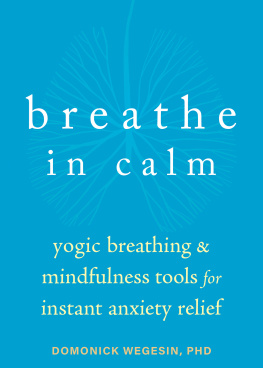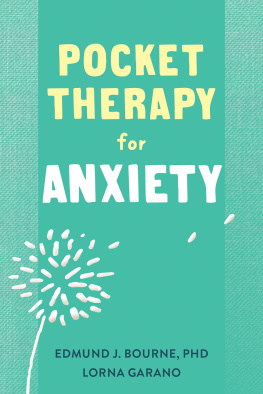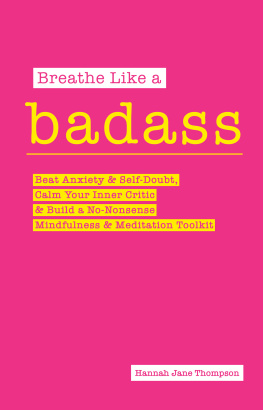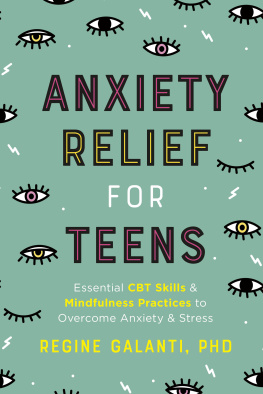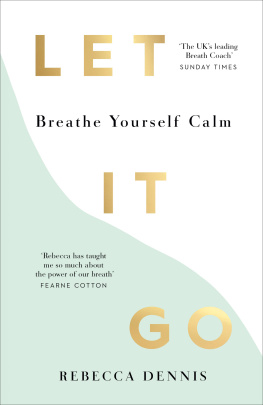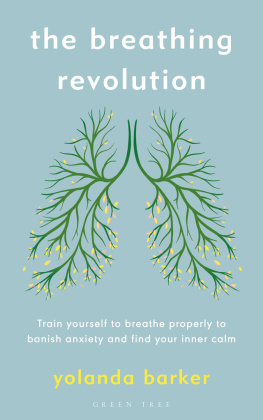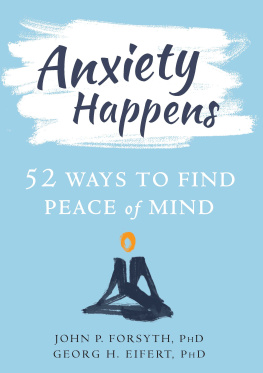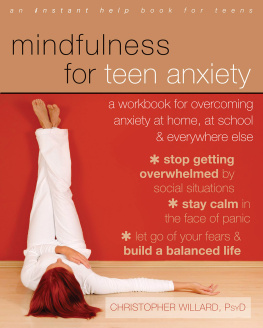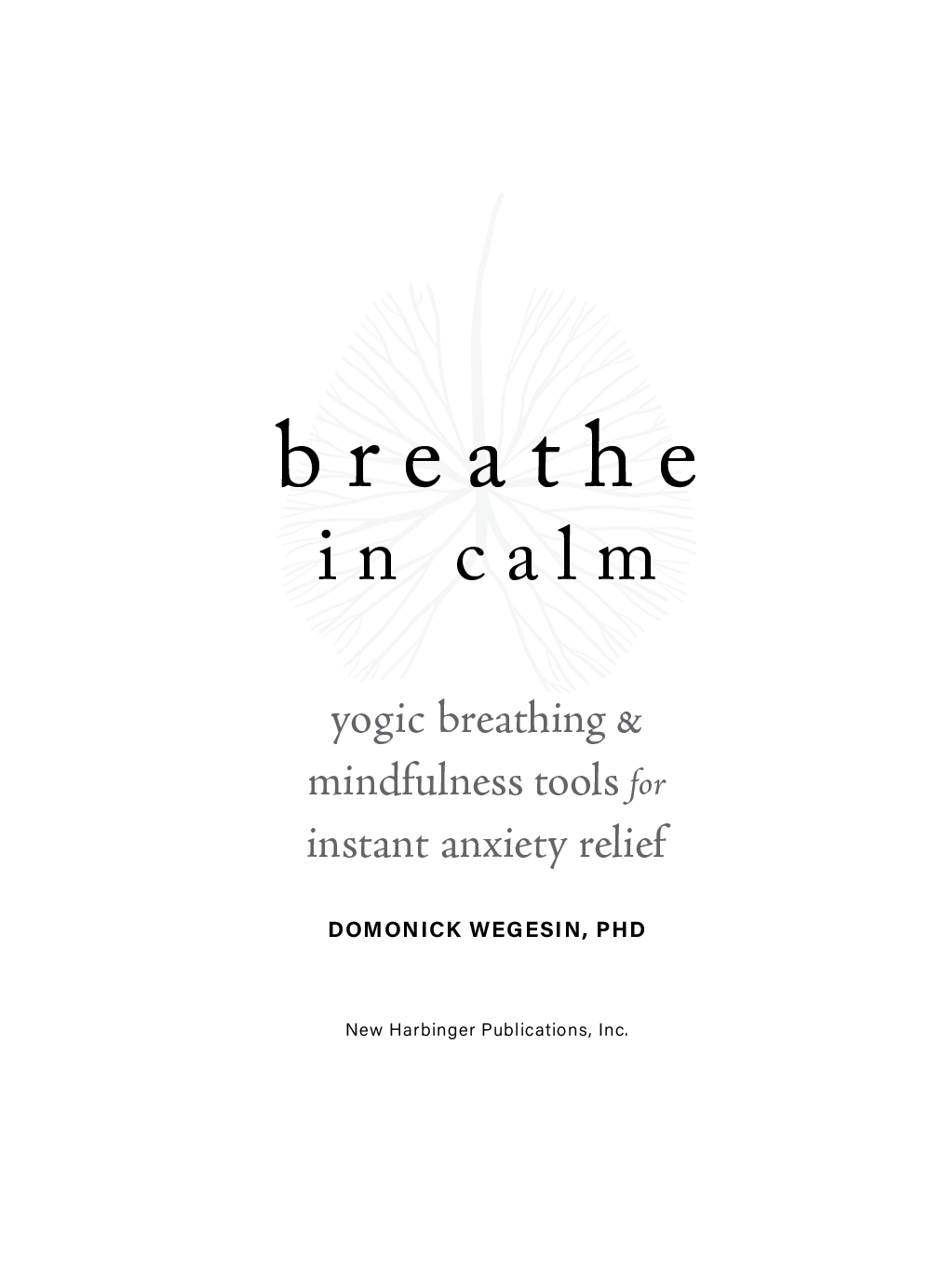Breathe In Calm is a wise, kind, and beautiful offering. This book provides practical, user-friendly methods to live better with anxiety for a lifetime.
Bob Stahl, PhD , coauthor of A Mindfulness-Based Stress Reduction Workbook , Living with Your Heart Wide Open , Calming the Rush of Panic , A Mindfulness-Based Stress Reduction Workbook for Anxiety , MBSR Every Day , and A Mindfulness-Based Stress Reduction Card Deck
Breathe In Calm is a lifesaver for anyone that has ever experienced anxiety. The simple yet powerful tools and practices are explained in a clear, practical, and easy-to-follow manner. The book reflects Domonick Wegesins years of experience helping people navigate anxiety through his deep mastery of science, yoga, and mindfulness.
Ashley Sharp , longtime yoga and meditation teacher, author of Mindfulness for Beginners , and founder of Refuge at Pudding Creek a retreat center in Northern California
Breathe In Calm is a timely and significant book; a vital antidote to the increased anxiety in our lives. Wegesin lives and writes with the integrity garnered from experience. The mindfulness toolbox of compassionate practices cultivates the healing power of the breath, a self-psychology that is always effective and available to us. I look forward to enthusiastically recommending this book to both colleagues and clients!
Preston Parsons, LCSW , psychotherapist, consultant, and mindfulness practitioner
Breathe In Calm is a breath of fresh air for anyone who experiences anxiety on any level, which means all of us. Wegesins evidence-based approach is both accessible and affirming. Combining cutting-edge neuroscience with the potent sharing of various students/clients who have successfully integrated these practices into their lives, this guide is as groundbreaking as it is grounding. Equal parts wisdom and wit, this book is bound to change your life.
Ken Breniman, LCSW , somatic psychotherapist, certified yoga therapist, thanatologist, and psychedelic and plant medicine integration specialist
Publishers Note
This publication is designed to provide accurate and authoritative information in regard to the subject matter covered. It is sold with the understanding that the publisher is not engaged in rendering psychological, financial, legal, or other professional services. If expert assistance or counseling is needed, the services of a competent professional should be sought.
Distributed in Canada by Raincoast Books
NEW HARBINGER PUBLICATIONS is a registered trademark of New Harbinger Publications, Inc.
Copyright 2021 by Domonick Wegesin
New Harbinger Publications, Inc.
5674 Shattuck Avenue
Oakland, CA 94609
www.newharbinger.com
Cover design by Sara Christain; Interior design by Amy Shoup and Michele Waters-Kermes; Acquired by Georgia Kolias; Edited by Jennifer Eastman
Peace Is This Moment Without Judgment, Leaves from Moon Mountain: Poems and Reflections by Dorothy Hunt. Collage art by Rashani Ra. San Francisco: Moon Mountain Sangha Publishing, 2015, p. 132. Reprinted with permission.
All Rights Reserved
Library of Congress Cataloging-in-Publication Data
Names: Wegesin, Domonick, author.
Title: Breathe in calm : yogic breathing and mindfulness tools for instantanxiety relief / Domonick Wegesin, PhD.
Identifiers: LCCN 2021026549 | ISBN 9781684038817 (trade paperback)
Subjects: LCSH: Yoga--Therapeutic use. | Anxiety disorders--Alternative treatment. | Breathing exercises--Therapeutic use.
Classification: LCC RM727.Y64 W44 2021 | DDC 615.8/24--dc23
LC record available at https://lccn.loc.gov/2021026549
I dedicate this book to all of my students who, over the years, have taught me so much about applying these mindful tools to real life. Thank you for your vulnerability, courage, and willingness to turn toward your anxiety with more compassion. Without your inspiration, I would not have written this book.
I also dedicate this offering to you, the reader. May these tools be of service to you in exploring and understanding the pain caused by your anxiety. May these words help you find relief from that pain.
Contents

Introduction: Anxiety and the Tools to Relieve It
Not long after moving to New York City, I enjoyed a delightful Sunday bike ride along the Hudson River north of the city. On my way back to Manhattan, I was racing down a long hill, feeling elated by the beautiful day, when an oncoming car took a quick left-hand turn and crossed unexpectedly in front of me. I had only seconds to slam on my brakes before colliding with the car. I remember flying upward and then waking up in the middle of the road some time later, unable to move. The vehicle had fled the scene. I suppose that the driver didnt want to be held accountable for my injuries after cutting in front of me when I had the right of way.
I was lucky. My now-broken helmet took the brunt of the impact, but my bones remained intact. What was troubling, however, was the automatic reaction my body started having to traffic after the accident. New York pedestrians are not great observers of the dont walk sign, and I jaywalked with the best of them. However, after the accident, my body would seize up any time I needed to cross a street, even when the walk signal assured my right of way. My breath would tighten, my heart would race, my muscles would clench, and my brain would paint gruesome scenarios of getting smashed by buses or slammed by taxis. I was a nervous wreck, even walking a few blocks to the subway.
The physiological changes that I experienced are part of the bodys fight-or-flight response. Your brain evolved to set off internal alarms at the approach of predators or the expectation of danger, which tell you to fight, flee, or freeze. Ideally, after the threat has passed, the fight-or-flight system switches off, and you calm down. This process is hard-wired through evolution and is critical for your survival, so its not something you can just uninstall.
Unfortunately, your fight-or-flight system can get stuck in a state of arousal, even when nothing threatening is happening. Your brain perceives that you are in danger when, in fact, you are safe. There are many reasons why this can happen: accidents, surgeries, chronic stress, bullying, emotional neglect, or any other kind of trauma. It could be a combination of things. Most anxious folks cannot pinpoint exactly why they are anxious. Thats okay. Theres a simpler way.

Instead of getting distracted by asking why you are anxious, Breathe In Calm will teach you to focus on what.
- What are your anxious symptoms?
- What are your triggers?
- What are your reactions to anxiety?
- What can you do to calm your anxiety?
- What will help you shift your relationship to anxiety so that it bothers you less?
Well learn and use a small but powerful set of toolsObserver, Breathing, Grounding, Acceptance, Choice, Story, and Kindness. Each of these tools will take its place in an overall strategy to transform your own personal relationship with your anxiety.
First, before you try to calm your anxiety, you have to realize that youre feeling anxious. This may sound elementary, but anxiety often is happening without your being fully aware of it. You may habitually hold tension in your shoulders, bite your nails, avoid eye contact, or feel restless without fully realizing it. Your mind is good at distracting you from anxious symptoms to avoid dwelling in the discomfort associated with them. However, in this mindful approach, you will turn your attention toward your anxiety in order to work with it more skillfully. Dont worry if youre not great at noticing all of your anxious habits yet, because the Observer Tool will improve your ability to notice anxious symptoms as soon as they appear.

